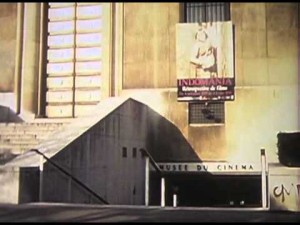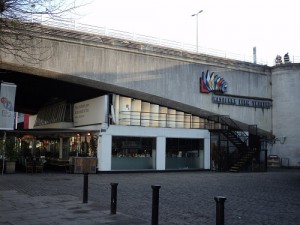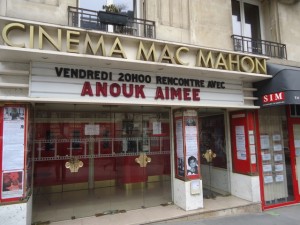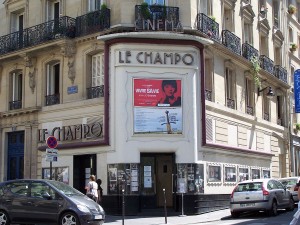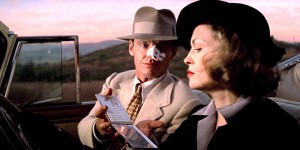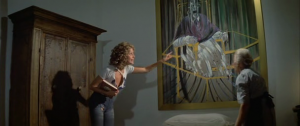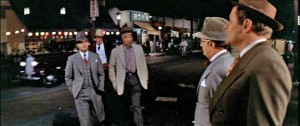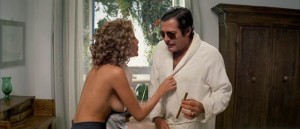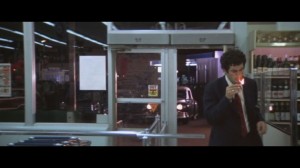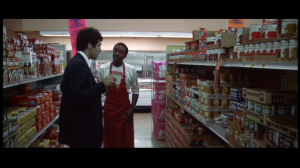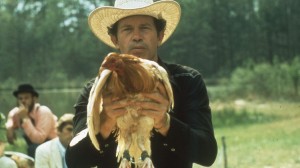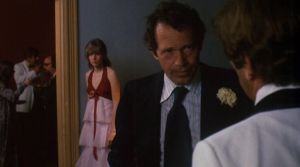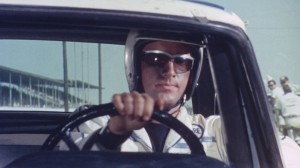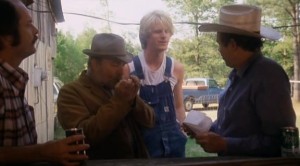From Film Comment, November 1974. I suspect that one factor that may have kept me from scanning and posting this column until now, at least in its complete form, is my dissenting view of CHINATOWN and WHAT?, even before the former became fully canonized as Holy Writ. -– J.R.
Moving across the Channel, a profound difference in the cinematic climate becomes immediately apparent. How could it be otherwise, considering that the lifestyles that go with each city are so strikingly antithetical? Paris is all adrenalin and shiny surfaces, hard-edged and brittle and eternally abstract, the capital of paranoia (cf. Rivette) and street spectacle (cf. Tati), where café tables become orchestra seats as soon as the weather gets warm — the city where everyone loves to stare. London is just the reverse, a soft-centered cushion of comfort where trust and accommodation make for a slower, saner, and ostensibly less shrill mode of existence: relatively concrete and prosaic, more spit and less polish, a city more conducive to eccentricity than lunacy. Relatively speaking, London isn’t a movie town. It’s considerably easier to go out to films in Paris and to be more selective about what one sees, because the area is smaller and the action tends to be more concentrated. Champs-Elysées alone is a nightly smorgasbord, the Latin Quarter a gargantuan feast, and each can be conveniently traversed by foot — theoretically, one can go shopping for movies as though at a supermarket. London, by contrast, is a sprawling expanse of adjacent villages where theaters tend to be further apart, and open later in the day; saturation bookings limit one’s choices more severely, and one commonly has to sit through endless stretches of nonsense (including two or three candy breaks) before the main feature comes on; audiences generally talk more during the films, and are much less prone to stick it out for the final credits….But paradoxically, and at the same time, the research facilities in London are incomparably better.
***
Bidding farewell to the city of projector lights, a crowd of movie-related memories both sweet and sour come to mind. For better and for worse, Paris probably remains the most cinematic of cities. Maybe, as Frankenheimer and others have suggested, it’s a function of the relative badness of the television, but other factors are undoubtedly involved as well. Paris abounds in specialized movies in much the same way that it has an unusual number of specialized bookstores; in both cases, small groups are catered to because of a setup that permits multiplicity on a scale that doesn’t compete with the mass market. And the physical experience of Paris is consummately cinematic, as local directors from Lumière to Bresson — by way of Feuillade and Godard —have amply demonstrated. Now that the Cinémathèque seems to be at least partially (and, one hopes, temporarily) buried beneath its deteriorating main auditorium of torn carpet and missing seats, its cancelled screenings and last-minute substitutions, its scrambled programs and garbled schedules, the growing rowdiness and decreasing number of cinephiles in its audiences, I’m sure I will nonetheless miss its inspired zaniness from time to time in the more dependable — if less dynamic —inner sanctums of the National Film Theatre. I’ll miss the opportunity to fight my way through teeming mobs to see VERTIGO and/or REAR WINDOW on alternate weekends, and chances to return to SCARFACE, HER MAN, LA NUIT DU CARREFOUR, THE ENCHANTED DESNA, and countless other recurring local specialties. And beyond the Cinémathèque, I’ll miss the revivals of directorial esoterica (e.g., Sirk’s NO ROOM FOR THE GROOM this past summer) even when I didn’t get a chance to see them; the cozy quarters of the Minotaur, a much warmer and more colorful corner for book and magazine browsing than London’s Cinema Bookshop; the cartoons, trailers, and bathroom graffiti at Studio Action Lafayette, and the curious pantheon of directors’ names in Studio Parnasse; the Dim body stocking ads (although one, at least, is preserved for posterity in TOUT VA BIEN); the giant photographs of Lang, Losey, Preminger, and Walsh (“The Four Aces”) that ominously guard over the stairway leading down to the auditorium at the Mac Mahon, and the equally fateful chime that rings there before the film begins; the letter-perfect projection of 2001 at Kinopanorama and the awfully dubbed comedy shorts at the Actua-Champo. Sniff gurgle choke: the list could go on for pages, but that’s enough for this city and this paragraph, before I drown in my own bathos. On to London and newer things.
***
August 6: CHINATOWN is fun, but why is nearly everyone greeting it like a Second Coming? Well-tooled machines are rare enough in Hollywood these days, but craft and efficiency aren’t the same things as freshness or inspiration, and this is almost certainly the least personal film of Polanski’s to date. WHAT?, his previous feature, has been vilified in most quarters as a sterile exercise in self-indulgence, perhaps because its commits the cardinal sin of reveling in its own devices — betraying the presence of a director who enjoys making movies. But even though the characters in WHAT? are devices too, they’re treated with an affection that is both unexpected and virtually unparalleled in Polanski’s work. Oddly enough, this lark of a movie exhibits a kind of tenderness towards its jaded cast of characters and their absurdities that almost makes it resemble a sunny remake of CUL-DE-SAC. CHINATOWN, a good deal trendier in its tight-lipped reticence and transparency, fails to commit such an impropriety; and audiences and critics are rewarding Polanski for sticking more strictly to the business of spinning a dispassionate yarn. They call it tougher, but I see it as leaner.
Is transferring a cold-eyed variant of Ross Macdonald to the screen, even if it’s decked out with goofy undertones, the best that can be hoped for in the private-eye genre? A quick skim of the English press on the subject of CHINATOWN seems to convey the general impression that it is. There’s an apparent preference here for reliable comfort (like a “good old” Chabrol or Graham Greene to curl up with) over unpredictable risk, which amounts to a ranking of known pleasures over undiscovered ones, at least in the commercial cinema. Characteristically, a lot of critics who’ve been celebrating CHINATOWN on both sides of the Atlantic tore into THE LONG GOODBYE last year for its “betrayal” of Raymond Chandler. The overall suggestion behind this complaint was that Altman had nothing better to do with his time than shift a few cherished, warmed-over myths from the Forties to a contemporary context. But notwithstanding Altman’s own somewhat less than helpful comments on the matter, so much noise has been made over this issue that no one seems to have noticed what the film does for Los Angeles — which is surely no less impressive a job than Chandler managed in his own way, and with kinkier implications besides. (ALPHAVILLE was widely misread at first in an analogous way: as failed science fiction, with Godard presumably trying to adapt Huxley or Orwell, rather than as the astounding poetic vision of Paris that it is.) As a replay of conventional L.A. itineraries, with a few extras thrown in for spice and spite, CHINATOWN is fluid and graceful even at its most familiar junctures, and all the allegorical play with desert and water gives the mind something to mull over whenever the stock figures become too tiresome. But THE LONG GOODBYE does something much more unusual and daring: instead of merely evoking Los Angeles, it reproduces the experience of that city structurally, in the textures and rhythms of its own discontinuities and ellipses.
Criss-crossing characters who fade and disappear from sight like diverging freeways — or, like the black guy in the supermarket and police station, reappear at a subsequent point as he and we drift off in opposite directions; shifting centers of meaning and attention that form the swirling eddies of a restless nightmare, punctuated by unforeseen eruptions and explosions (like the extraordinary, manic, nocturnal appearances of Mark Rydell as the Jewish gangster); the total absence of community that makes every inhabitant a separate island, vaguely “foreign” and slightly crackers to everyone else, each on his own special time-scale and wavelength, whistling or humming his own private arrangement of the title tune: what other movie has so precisely captured the surreal dislocations of L.A.?
CHINATOWN isn’t half as scary: with its clean, linear story-building, its attractively composed frames, and its sexier ads —not to mention its more glamorous star presences – it sets out to satisfy more than provoke, and succeeds pretty well in the task. But speaking personally, I wish that Polanski would get back to making films for himself.
***
August 12: Monte Hellman’s COCKFIGHTER. On his own more modest level, Hellman seems to be attempting much the same game as Polanski’s: to elicit all the necessary cheers from the peanut gallery while continuing to play some of his favorite formalist tunes in the bass clef, intermittently abstracting the material at hand. In CHINATOWN — to my eyes and ears, at any rate — the formalist counter-line is minimal and mainly submerged, arising on occasion to take the center (as when we hear, and then see, workmen scratching a name off on office door), but usually kept on the hinges of the Time Magazine-cover characters, who clog up most of the remaining space. In other words, the formal games seem to be played around and between the characters rather than — as was more often the case in WHAT? — waged through them. In COCKFIGHTER, the accommodation of the commercial and formal strains is rather more complex, involving interaction as well as co-existence. The peanut gallery merges with the cockfight spectators in the film, and Hellman manages to suggest the point — without ever forcing it — that watching a movie called COCKFIGHTER is fundamentally just about as ridiculous as watching a cockfight. Working in a genre that is every bit as conventional and predictable as the private-eye story, Hellman comes up with something much closer to genuine absurdism than Polanski’s cocktail party cynicism.
Consider the plot: a cockfighter (Warren Oates) loses two bets and two birds. One of the victors advises him that he drinks too much and talks too much, and Oates immediately takes a vow of silence, not to be broken until he’s proclaimed Cockfighter of the Year, whatever that means. (To sidestep this refusal on narrative terms, Hellman permits him occasional offscreen remarks as narrator, mainly laconic factual observations.) He joins forces with a Polish immigrant who supplies betting money, birds, and encouragement, and ultimately wins the coveted medal.
It is difficult for me to think of a more idiotic and gratuitously brutal sport than cockfighting. I happen to find the daredevil flying in ONLY ANGELS HAVE WINGS and the car-racing in RED LINE 7000 almost equally ridiculous ways for grown men to spend their time, but perhaps for just this reason I have no difficulty in accepting these activities in both Hawks films as metaphysical metaphors — even though Hawks insists on treating and honoring them concretely, as camped-up reflections of his own experiences with cars, planes, and the men who drive them.
I haven’t the foggiest notion of what Hellman thinks about cockfighting per se, but the fascination with games and competitions that persists throughout THE SHOOTING and TWO-LANE BLACKTOP is always tempered by the dryly comic notion that all of them are pretty silly. And nothing could be sillier than the aspirations and exploits of Oates in COCKFIGHTER. One isn’t necessarily persuaded that he loses because of his bragging or drinking, or that he wins because of any intervening moral growth or increasing amount of expertise. (After all, it is his Polish partner who gets him on his winning streak, and the fights ultimately belong to the birds, not the bettors.) For all the arcane bits of inside information that Oates imparts about his trade, he mainly comes across as a likable, brainless twerp who nurtures a mythical sense of purpose, like some variant of Hemingway’s Old Man of the Sea recast as Don Quixote in a hillbilly context.
The cutting edge of Hellman’s treatment of this Roger Corman quickie can be seen in the wonderful crowds that he collects around the cockfights, or his uncanny talent for directing rural speech to make it sound like crazed ritual incantation. As a native of Alabama, I have a sore point about Yankee approximations of Deep South accents and gestures that are indifferently observed: next to such models of precision as THE PHENIX CITY STORY, BABY DOLL, and WILD RIVER, the grotesque caricatures in films like SWEET BIRD OF YOUTH, I WALK THE LINE, THIS PROPERTY IS CONDEMNED, and (much as I regret to say it) Renoir’s THE SOUTHERNER, tend to drive me up the nearest wall. Suffice it to say that in both his direct use and his paraphrases of the look and speech of local yokels, Hellman has an infallibly witty and accurate ear and eye.
In fact, the mean, caustic bite of the humor in COCKFIGHTER reminded me more than once of Flannery O’Connor. The evangelist hero of Wise Blood observes at one point that any man that’s got a good car don’t need to be justified, and the obstinate pride and conceit of the Oates character about his own stature seems to belong to much the same world. (The cockfights themselves inevitably suggest the depiction of one in Nathanael West’s The Day of the Locust, and O’Connor is one of the few serious disciples of West, most of all in her treatments of violence.) Is it by chance or design that Hellman sets his climatic cockfight in Milledgeville, Georgia, the town where O’Connor lived for most of her life? (For all I know, the setting may have come from the novel the film is based on, or some inside knowledge about cockfighting circuits, but the possibility seems worth noting.) This isn’t a major Hellman job, but it will do just fine until one comes along. Less interesting than THE SHOOTING and less pretentious than TWO-LANE BLACKTOP, it is at the very least an engaging minor treat.

